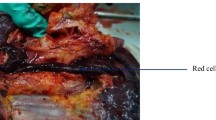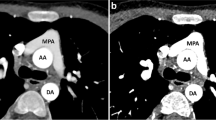Abstract
Computed tomography (CT) is widely accepted in adult forensic death investigations (determination of cause and manner of death) but is only beginning to play a larger role in the cause of death determination in infants and children. We present a case of an adolescent with nephrotic syndrome who sustained cardiac arrest and died in the emergency department. A postmortem CT was requested by the state Office of the Medical Examiner as part of the medicolegal death investigation. Postmortem CT showed a saddle pulmonary embolus that was confirmed on conventional autopsy, demonstrating a natural manner of death.




Similar content being viewed by others
References
Proisy M, Marchand AJ, Loget P et al (2013) Whole-body post-mortem computed tomography compared with autopsy in the investigation of unexpected death in infants and children. Eur Radiol 23:1711–1719
Thayyil S, Sebire NJ, Chitty LS et al (2013) Post-mortem MRI versus conventional autopsy in fetuses and children: a prospective validation study. Lancet 382:223–233
Sieswerda-Hoogendoorn T, Soerdjbalie-Maikoe V, de Bakker H et al (2014) Postmortem CT compared to autopsy in children; concordance in a forensic setting. Int J Legal Med 128:957–965
Arthurs OJ, Taylor AM, Sebire NJ (2015) Indications, advantages and limitations of perinatal postmortem imaging in clinical practice. Pediatr Radiol 45:491–500
Arthurs OJ, Guy A, Thayyil S et al (2016) Comparison of diagnostic performance for perinatal and paediatric post-mortem imaging: CT versus MRI. Eur Radiol 26:2327–2336
Levy AD, Harcke HT, Mallak CT (2010) Postmortem imaging: MDCT features of postmortem change and decomposition. Am J Forensic Med Pathol 31:12–17
Okuma H, Gonoi W, Ishida M et al (2014) Greater thickness of the aortic wall on postmortem computed tomography compared with antemortem computed tomography: the first longitudinal study. Int J Legal Med 128:987–993
Ampanozi G, Held U, Ruder TD et al (2016) Pulmonary thromboembolism on unenhanced postmortem computed tomography: feasibility and findings. Legal Med 20:68–74
Author information
Authors and Affiliations
Corresponding author
Ethics declarations
Conflicts of interest
None
Rights and permissions
About this article
Cite this article
Harty, M.P., Harcke, H.T., Gould, S.W. et al. Pulmonary embolus as cause of death in an adolescent: demonstration on postmortem CT. Pediatr Radiol 48, 745–748 (2018). https://doi.org/10.1007/s00247-017-4041-4
Received:
Revised:
Accepted:
Published:
Issue Date:
DOI: https://doi.org/10.1007/s00247-017-4041-4




